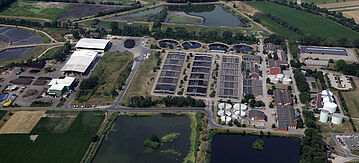Sewage Treatment Plant

More than 95 percent of the German population (79 million inhabitants) are linked to the public sewage system (2004). Waste water is treated in more than 10,000 sewage treatment plants. The sewage system extends to approximately 515,000 kilo meter in length and would be long enough to circle the planet 13 times. In general, municipalities are responsible for waste water treatment facilities. There are, however, also privately owned sewage treatment plants in industry. Around 9.4 billion cubic meter of waste water are treated annually in public waste water treatment facilities.
Almost 100 percent of the waste water is treated in sewage works with three purification stages:
- a mechanical stage,
- a biological stage without elimination of nutrients such as nitrogen and phosphates,
- an additional biological purification stage with specific nutrient elimination.
The total number of biological treatment facilities has been constantly increasing. This has led to an encouraging increase in oxygen levels in all water bodies and improved the living conditions for fish fauna and other aquatic organisms.
Stages of a modern sewage treatment plant
First purification stage = mechanical waste water treatment
- First of all the waste water passes a bar screen which holds back larger solid objects such as paper, bottles, branches and tins and removes them by means of an automated mechanical rake.
- The sewage channel broadens out into the grit chamber, reducing the velocity of the incoming sewage and thus allowing coarser particles such as gravel and sand, which are heavier than water, to settle at the bottom.
- In the primary settlement tank the water is retained for approximately two hours. In this large rectangular or round settlement tank fine suspended particles can settle as sludge at the bottom. This raw sludge is removed, thickened and transferred to a digestion tank. Light particles floating on the water's surface such as fat and mineral oil are skimmed off and discharged into a separate tank.
The first three stages make up the first purification stage. As it involves purely mechanical treatment of the waste water it is also referred to as the mechanical treatment stage. This stage removes approximately 30 percent of polluting matter from the inflowing raw waste water the plant has to process in total.
Second purification stage = biological waste water treatment
- In the second or biological purification stage a natural process is used by passing the sewage liquor into an aeration tank. In an activated sludge process oxygen is inserted into the liquor to create favourable conditions for microorganisms which feed on solved organic particles in the effluent and accumulate the ingested matter. During this process pollutants such as heavy metals are also ingested.
- A large number of microorganisms form colonies which become visible as sludge flocs. These sludge flocs settle at the bottom of the subsequent secondary settling pond or clarifier and are either returned to the activated sludge process or pumped into the primary settling pond for sludge disposal. Hence, the removal of sewage sludge from the effluent eliminates the bio-degradable pollutants. Smaller sewage treatment plants often use trickling filters, i.e. round concrete tanks loosely filled with porous rocks which provide a large surface area needed by the bacteria to settle. They form a continuous film ("biofilm" – similar to the sludge flocs of the activated sludge process) over which the discharged effluent is passed. The mechanical and biological treatment stages clean the effluent to a degree of approximately 90 percent.
Third purification stage = additional waste water treatment
Today waste water is generally polluted with chemical substances such as nitrogen and phosphate which makes it necessary to apply additional special processes:
- In the example shown in the illustration liquor containing phosphate from the secondary settling pond is first of all fed into a flocculation tank.
- In this stage the effluent undergoes vigorous mixing and a dosing pump for precipitants simultaneously dispenses a chemical solution in the liquor.
- This precipitant reacts chemically with the phosphates and forms a water-insoluble compound and the residual contaminants form flocs which settle in a subsequent clarifier as sludge. This sludge is thickened and transferred to the digestion tank.
- The cleaned waste water can now be discharged into the natural environment.
Sludge treatment and disposal
The sludge accumulating in two stages has a water content of approximately 98 percent.
- The addition of thickening agents helps to bring this down to 96 percent, reducing the sludge volume by 50 percent.
- The sludge is subsequently discharged into a digestion tank. In an anaerobic fermentation process a digester gas is formed at a temperature of 35 degree Celsius which consist of 2/3 of methane and 1/3 of carbon dioxide.
- This gas is stored in a separate tank to be used as fuel for heating.
- After approximately 4 weeks the digestion process is completed and the then odour-free sludge is discharged into a sludge drying bed for dewatering.
As a rule, larger industrial enterprises have their own sewage treatment works with technical processes adapted to their specific conditions. In the western part of Germany more than 90 percent of the population is linked to the public sewage system whereas the quota in the eastern part of Germany is about 66 percent.
